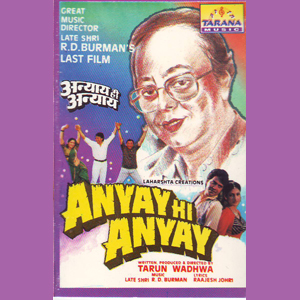Seedhi Raah Par Chala Phir Bhi

Song: Seedhi Raah Par Chala Phir Bhi….
Film: Anyay Hi Anyay (1997)
Producer: Tarun Wadhwa
Director: Tarun Wadhwa
Lyricist: Aanand Bakshi
Singer: Kumar Sanu
From “Anyay hi anyay”, Rahul Dev Burman’s searing title track is a study in how to capture the essence of a movie theme (never mind that it’s a B-grade movie) without going overboard. In this writer’s humble opnion, a real haunting, reflective piece of work, and one that surely grows on you with multiple listenings. Personally, I really love this 8 minute beauty. While other composers ensured that a title song that had a grouse or a heart wrenching cause as its theme played out loud and screaming, Pancham underplayed such tracks – he let the quietness of the protest be the cry, he allowed the frustration seep through with minimal orchestration, he let his orchestra reflect the poignancy, not the melodrama. He let RD be RD, no matter what the situation and he shone through, never mind what was happening on the ground.
The song opens with the chorus and before you can say, “Ah, another one of those…”, there’s the santoor that comes down, clear and precise, as only RD could make it to be. There’s the church bells, violins, and santoor again (sounding a distant relative of “Jaane kya sochkar”). When Kumar Sanu begins “Seedhi raah chala, phir bhi chal na saka”, the slow, dragging tabla comes along, adding an effect of defeat, world-weariness to the lyrics, along with the church bells and the beat. There’s also
the beautiful bass supporting the tabla that you look for, once you notice it. The tune slowly rises with “Sachai ke aanchal mein”..and then the tune comes down a couple of scales “,…sisak raha hai nyay” and then the title of the song, and the tune grows, encompassing, the violins turn as if in a vertigoish swirl before KS sings, “Anyay hi anyay”, the violins, and the chorus, repeating the title.
The first interlude has a heart-stopping bass and madal interplay – god, only RD could this, so brilliantly – before the violins come in, telling their own lovely story; the chorus, and then the antara, which is the mukhda tune actually, and the bass more prominent, as is the triangle, and Pancham introduces a pause in the singing to introduce a lovely pathos filled flute, which then supports KS through this verse, beautifully swirling with the “Anyay hi anyay” tune. Simply beautiful.
The second interlude has the bass and the madal again, and then the goose-bumpy flute that’s impeccable. The violins follow, rising, then falling, picked up by the chorus, and then the second verse follows. This time, no flute, but the beautiful violins again.
The third interlude has some beautiful santoor, violins after the bass and madal, but the third verse follows quickly, and the title name is supported by violins, chorus, and then the crescendo, ending the song.
Truly, it’s anyay hi anyay that this song doesn’t quite find the playtime it deserved. Another recurring theme in Pancham’s life and career.
Vineet Upendra
panchammagic.org

